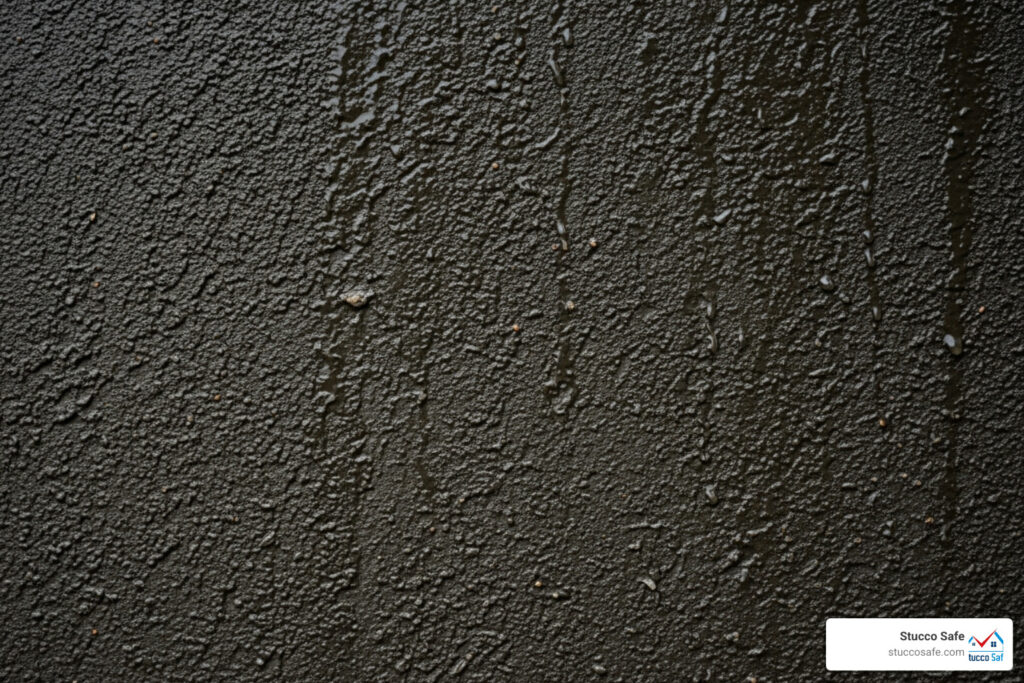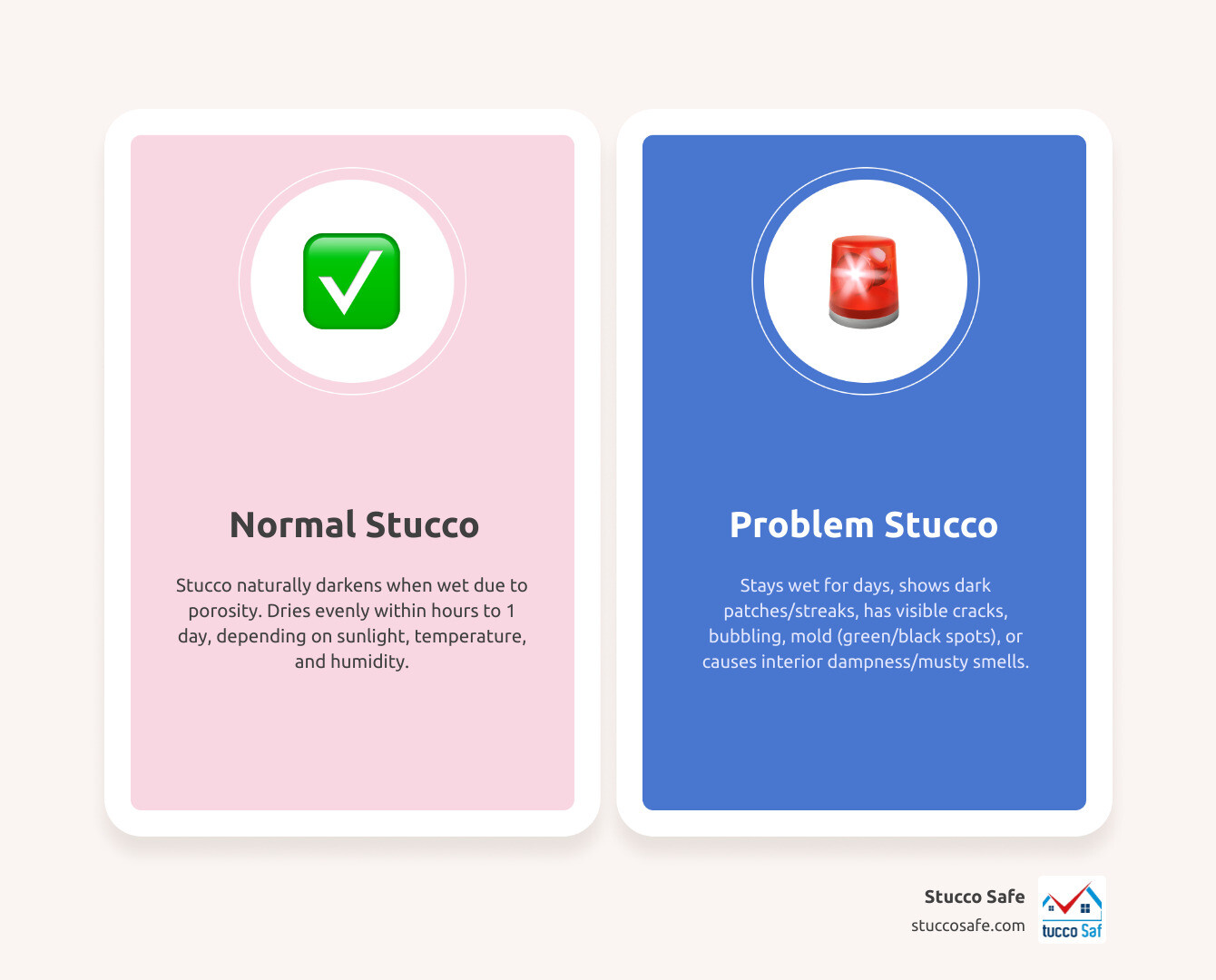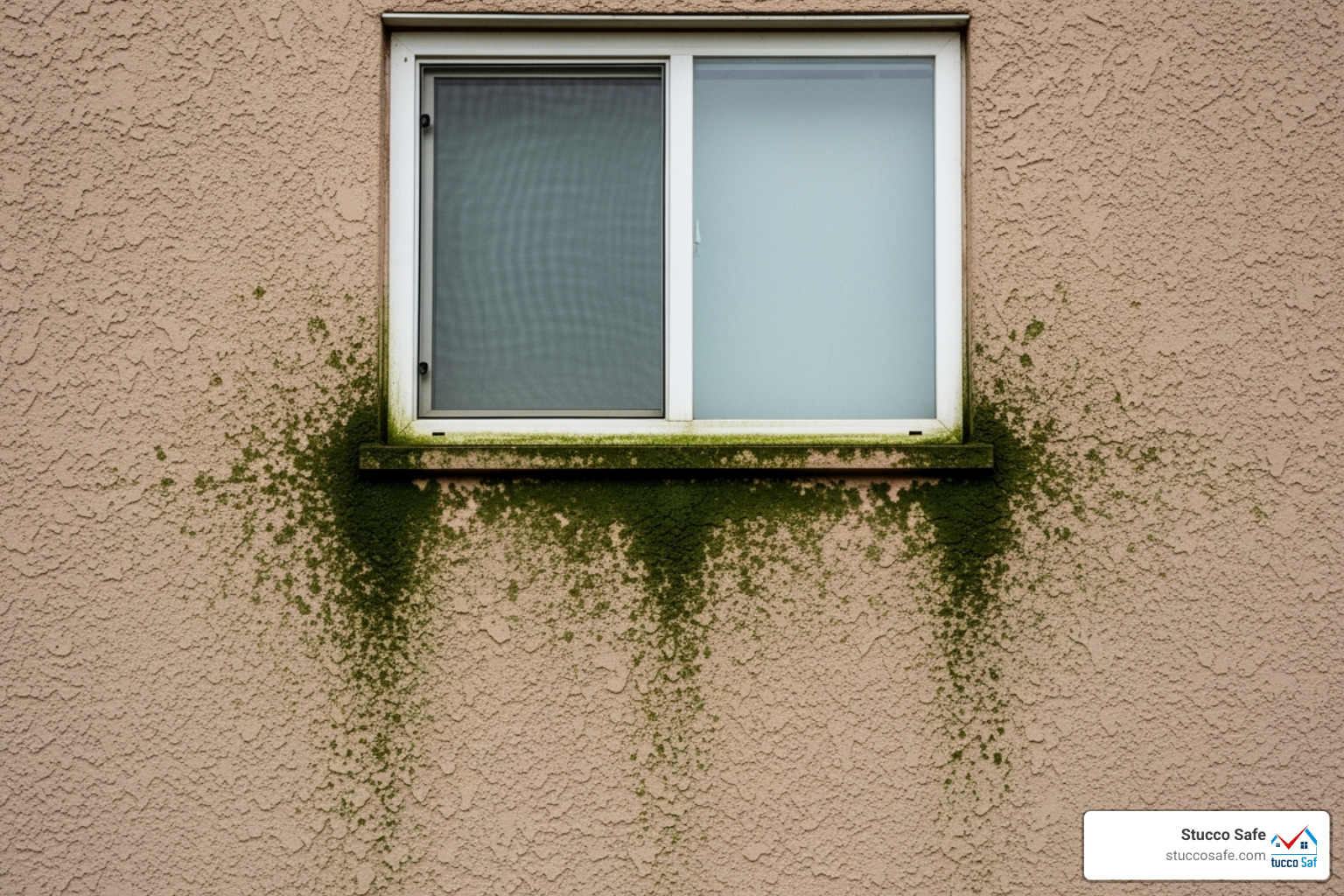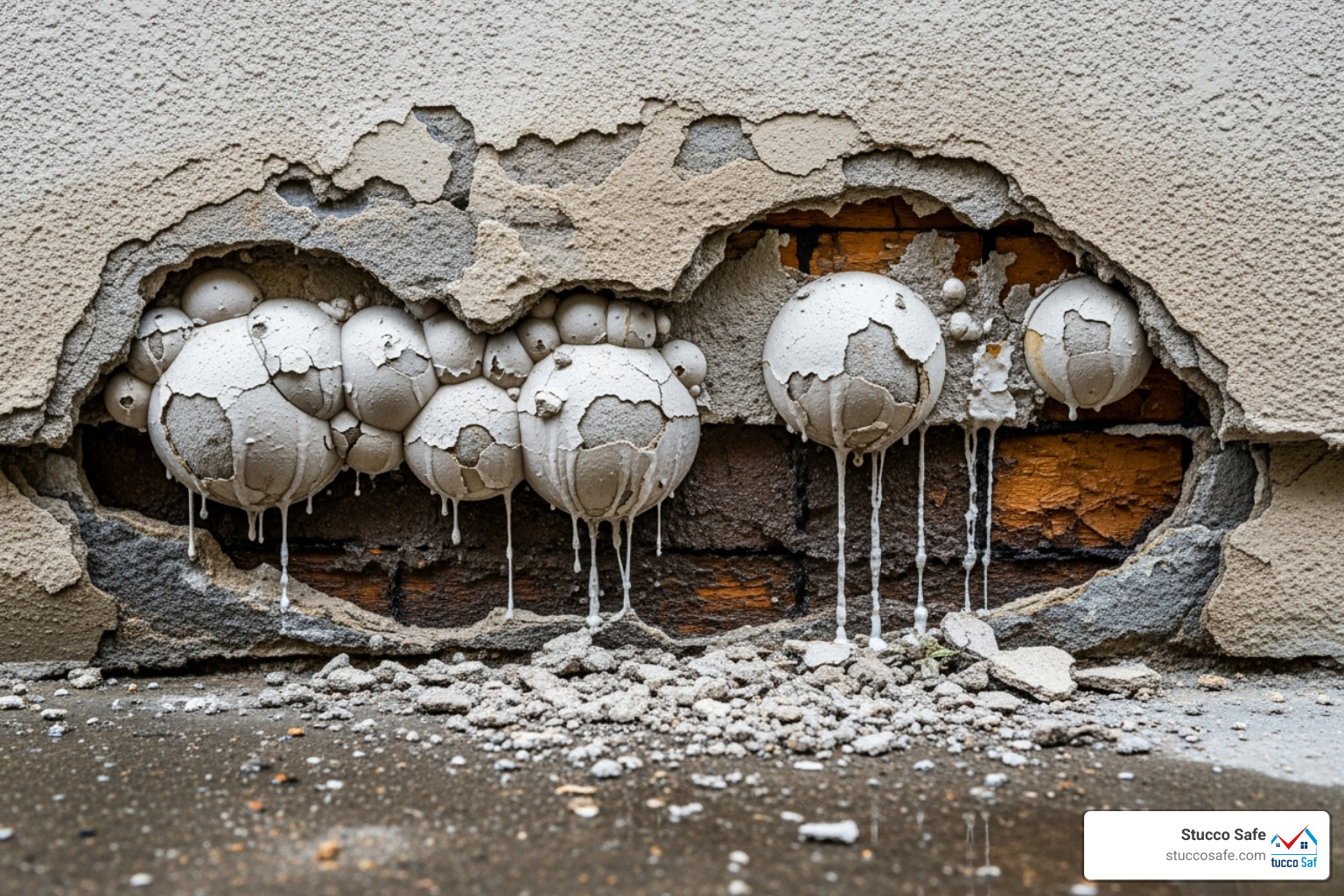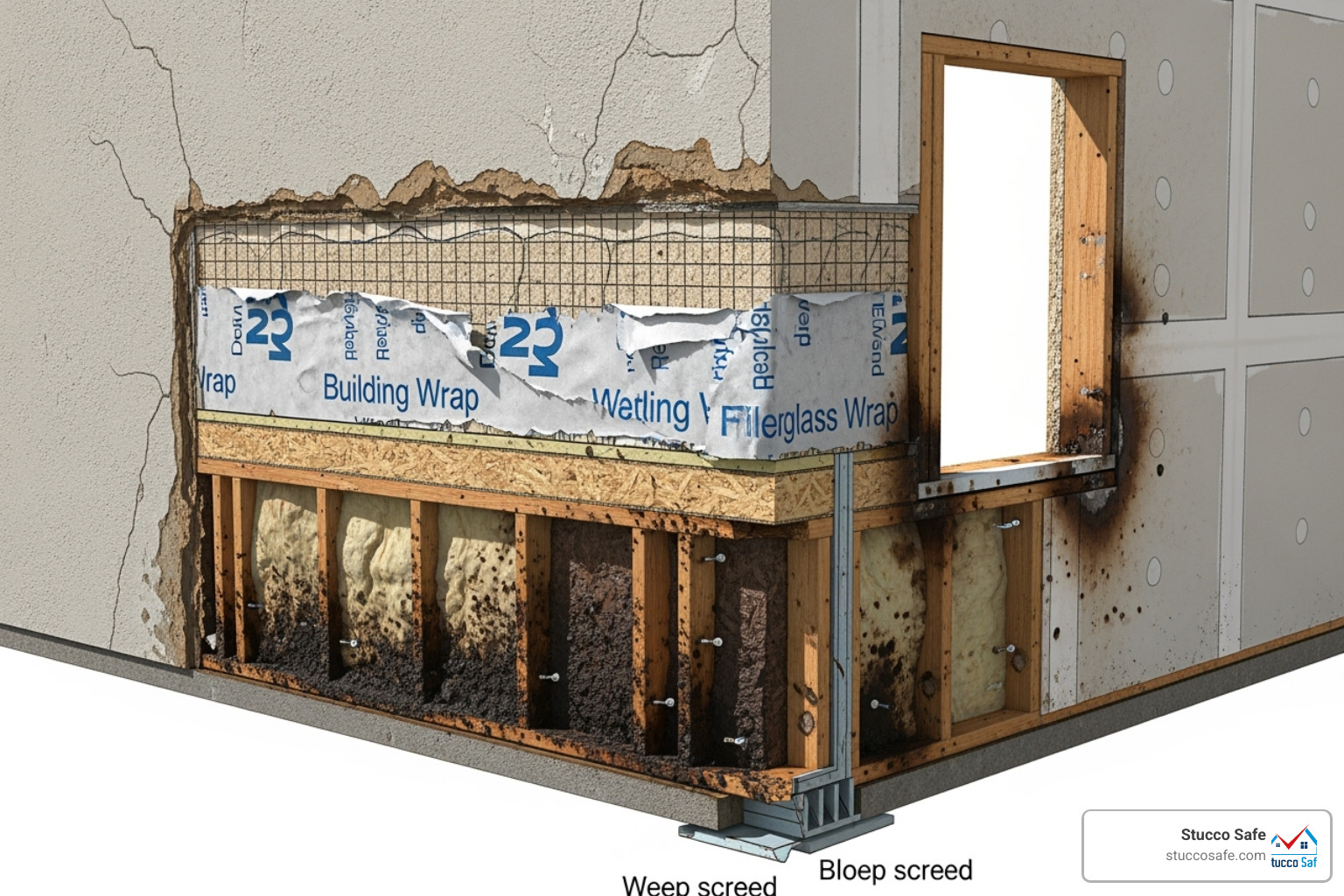Stucco wet after rain: 3 Urgent Concerns
Why Your Stucco Looks Dark After Rain
Stucco wet after rain is a common sight that makes many homeowners wonder if something’s wrong with their home. Here’s what you need to know:
Normal vs. Concerning Signs:
- Normal: Stucco darkens when wet, dries within hours to 1 day, dries evenly across the surface
- Concerning: Stays wet for days, never fully dries, shows dark patches or streaks, has visible cracks or bubbling
When to Worry:
- Persistent dampness lasting more than 48 hours after rain
- Green or black spots indicating mold growth
- Soft interior drywall below windows
- Musty smells near stucco walls
Stucco is a porous material made from sand, cement, and water. When it rains, this concrete-like surface naturally absorbs moisture and appears darker – just like a sidewalk after a storm. The key difference is how quickly it returns to normal.
Healthy stucco should dry within a few hours to a day, depending on sunlight, temperature, and humidity. But when stucco stays wet for days or shows uneven drying patterns, it often signals water getting trapped behind the surface where serious damage can occur.
I’m Gabe Kesslick, and I’ve been investigating stucco wet after rain issues since 2001 through leak detection and forensic inspections. As an EDI Level 2 Certified Stucco Inspector, I’ve seen how seemingly minor moisture concerns can hide major structural problems that cost homeowners tens of thousands in repairs.
The Normal Drying Process: What to Expect from Healthy Stucco
Waking up to a stucco home with dark patches after a storm can be alarming, but don’t panic. This is completely normal and shows your stucco is doing its job.
Stucco wet after rain is simply your home’s exterior “breathing.” Like a sponge, stucco absorbs moisture during rainfall and slowly lets it evaporate. This natural process causes the temporary color change you’re seeing.
How long should this take? Healthy stucco typically dries within a few hours to about a day after the rain stops. However, the drying time isn’t the same everywhere on your house.
A south-facing wall with full sunlight exposure will dry much faster than the shaded north side. Temperature plays a big role too – your stucco will dry quickly on a warm, breezy day but might stay damp longer during cool, still weather. High humidity levels can also slow things down, while good air circulation helps speed up the process.
Think of it like laundry on a clothesline – same principle, different material.
New stucco is a special case. If you’ve recently had stucco installed, you might notice it stays damp longer, and that’s not just okay – it’s essential! New stucco curing requires the material to stay moist for at least 48 hours. This isn’t a flaw; it’s chemistry at work. The water helps cement particles bond properly, creating the strong, durable surface that will protect your home for decades.
During those first two days, contractors actually work to keep new stucco damp by misting it regularly, especially in hot or dry conditions. If new stucco dries too quickly, it can become weak and chalky – definitely not what you want on your home’s exterior.
The key to recognizing healthy stucco is consistency. When your stucco dries evenly across the surface and returns to its original color within a reasonable time, you’re looking at a system that’s working properly. For more details about how stucco handles moisture absorption, check out Does Stucco Absorb Water?.
But what happens when this normal process goes wrong? That’s when stucco wet after rain becomes a red flag worth investigating.
Red Flags: When Stucco Wet After Rain Becomes a Major Concern
While it’s normal for stucco to darken with rain, there’s a crucial difference between healthy absorption and problematic water intrusion. When your stucco wet after rain crosses this line, you’re looking at potential hidden damage that could compromise your home’s structural integrity.
I’ve investigated hundreds of homes where homeowners initially brushed off discoloration as “just how stucco looks after rain.” Unfortunately, many of these cases revealed extensive rot, mold growth, and structural damage hidden behind what seemed like minor cosmetic issues. The key is knowing when that wet stucco appearance signals trouble brewing beneath the surface.
Persistent Dampness and Uneven Drying
Here’s where things get concerning: if your stucco wet after rain doesn’t return to normal within a reasonable timeframe, you’re likely dealing with trapped moisture. Healthy stucco should dry within hours to a day, depending on weather conditions. When it stays visibly damp for days or even weeks after the last rainfall, that’s your home waving a red flag.
Pay special attention to uneven drying patterns. Does one section of your wall remain dark and damp while the rest dries normally? Are there persistent dark patches that never seem to disappear, even during dry spells? These inconsistencies often indicate that water has found its way behind the stucco system and can’t escape properly.
These stubborn wet spots frequently develop into breeding grounds for mold and mildew. What starts as a simple dark patch can quickly become a health hazard and structural nightmare. The moisture gets trapped between the stucco and your home’s framing, creating the perfect environment for decay and deterioration. For more insight into these patterns, check out our guide on Stucco Water Stains.
Visible Damage: Cracks, Bubbling, and Stains
Sometimes the warning signs are impossible to miss. When stucco develops visible damage, it’s often your home’s way of crying for help.
Cracks are particularly troublesome because they create direct pathways for water infiltration. While tiny hairline cracks might be normal aging, larger or expanding cracks invite moisture deep into your wall system. I’ve seen homeowners spend hundreds patching these cracks, only to watch them reappear because the underlying moisture problem was never addressed. Learn more about proper crack repair at How to Repair Exterior Stucco Cracks.
Bubbling or blistering is especially alarming because it shows water has already penetrated behind the stucco finish. The trapped moisture causes the stucco to separate from the underlying surface, creating those telltale bubbles. This damage often appears at the base of walls or around windows and doors where water tends to accumulate.
Crumbling or soft stucco indicates severe moisture damage or poor installation. When stucco feels brittle or literally falls apart when touched, it’s lost its protective qualities entirely. Your home’s exterior envelope has been compromised.
Green or black spots are dead giveaways for mold or mildew growth. These organisms thrive in consistently damp conditions, and their presence on the exterior often means there’s much more extensive growth hidden behind the stucco where you can’t see it.
Interior Signs of Water Intrusion
Don’t forget to look inside your home for clues about exterior moisture problems. Sometimes the first signs of stucco wet after rain issues appear on your interior walls rather than outside.
Musty odors near exterior walls are strong indicators of mold or mildew growth within the wall cavity. This smell means moisture has penetrated your stucco system and created ideal conditions for these harmful organisms to flourish.
Damp or soft drywall is another clear warning sign, especially below windows or at the base of exterior walls. When interior surfaces feel spongy or show moisture damage, it directly correlates with water intrusion through the exterior stucco system.
Peeling paint or wallpaper on interior walls adjacent to stucco can signal moisture seeping through the wall assembly. The trapped water eventually finds its way to the interior, causing finishes to fail and potentially creating health hazards.
Unexplained moisture in basements or crawl spaces sometimes connects to exterior envelope failures, including stucco moisture problems. While not always directly related, persistent dampness in these areas warrants investigation.
If you suspect mold growth, understanding how to properly assess the situation is crucial. Check out our guide: How Can You Check for Mold in Your House?.
The bottom line? When stucco wet after rain persists beyond normal drying times or comes with any of these warning signs, it’s time to take action. Ignoring these red flags can lead to thousands of dollars in structural repairs and potential health issues for your family.
Uncovering the Cause: Why Stucco Moisture Problems Happen
When your stucco wet after rain becomes a persistent problem, it’s rarely just bad luck. After two decades of investigating moisture issues, I can tell you that most problems trace back to specific failures in how the stucco system was designed, installed, or maintained. Think of stucco like a raincoat – it’s meant to shed water, but if there are holes in the fabric or the seams aren’t sealed properly, you’re going to get soaked.
The frustrating reality is that many of these problems were built right into the house from day one. Especially for homes constructed between 1993 and 2006, we see failure rates as high as 90% due to inadequate building codes and rushed construction practices during the housing boom.
Why Your Stucco Stays Wet After Rain: Installation & Drainage Failures
Here’s what I’ve learned from crawling around thousands of homes: stucco systems fail when water can’t escape. It’s that simple. Stucco is designed to manage moisture, not be completely waterproof. But when key drainage components are missing or installed incorrectly, water gets trapped behind your walls like a hidden swimming pool.
Missing weep screed is one of the biggest culprits we encounter. This metal strip at the bottom of your stucco walls might look like just a trim piece, but it’s actually a critical drainage component. When it’s missing or when stucco is applied below ground level, water has nowhere to go except into your foundation and framing.
Kick-out flashing failures cause some of the most expensive damage we see. This small piece of metal at roof-to-wall intersections directs water into gutters instead of down your stucco walls. Without it, every rainstorm sends a waterfall directly onto your siding. I’ve seen homes where missing kick-out flashing caused tens of thousands in rot damage.
Inexperienced contractors often skip the rainscreen gap – a small air space behind the stucco that allows moisture to drain and walls to breathe. This gap is like giving your house lungs. Without it, any water that penetrates the stucco just sits there, creating perfect conditions for mold and rot.
Poor sealing around windows and doors creates easy entry points for water. We frequently find that caulking was either done poorly during construction or has failed over time, allowing water to seep behind the stucco at these vulnerable spots.
The pattern we see repeatedly is that these aren’t random failures – they’re systematic problems that stem from cutting corners during construction. You can learn more about why these issues are so common in our detailed guide: Why Does Stucco Have Problems?. For additional insights into the root causes, this external resource provides valuable perspective: Understanding why stucco problems occur.
The Critical Role of a Weather-Resistant Barrier
Behind your stucco lies what I consider the unsung hero of your home’s protection: the weather-resistant barrier (WRB). This layer – sometimes called a moisture barrier – is like having a backup goalkeeper. Even if some water gets past your stucco, this barrier should catch it and direct it safely away from your home’s structure.
When this barrier is improperly installed, damaged, or missing, water that penetrates the stucco has a direct highway to your home’s wooden framework. I’ve opened up walls where the barrier was installed upside down, had gaps at seams, or was punctured during construction and never repaired.
The consequences of barrier failure are devastating. Trapped water behind stucco creates the perfect storm for destruction. Your home’s sheathing starts rotting from the inside out, often completely invisible until the damage is extensive. We’ve found homes where entire sections of wall framing needed replacement because water had been slowly destroying the structure for years.
Mold growth thrives in these dark, damp wall cavities. Unlike the visible mold you might see on your bathroom tile, this hidden mold can spread throughout your wall system, affecting indoor air quality and creating serious health concerns for your family.
What makes this particularly frustrating is that these problems are entirely preventable with proper installation and quality materials. The weather-resistant barrier is your home’s insurance policy against water damage, but only if it’s installed correctly and maintained over time.
Understanding how this critical component works and why it fails is essential for any homeowner dealing with stucco wet after rain issues. For more detailed information about moisture barriers and their role in stucco systems, visit our comprehensive guide: Moisture Barrier Stucco.
From Patching to Prevention: Your Guide to Stucco Solutions
When you find that your stucco wet after rain is more than just a cosmetic concern, it’s natural to feel overwhelmed. But here’s the encouraging news: effective solutions exist, and understanding your options is the first step toward protecting your home and your investment.
The key shift we encourage homeowners to make is moving from reactive patching to proactive prevention. Too often, we see homeowners spending money on quick fixes that don’t address the real problem, only to face the same issues again a few years later. Smart homeowners focus on long-term solutions that tackle the root causes of moisture intrusion.
This is where proactive maintenance becomes your best friend. Regular professional inspections can catch problems before they become expensive disasters. Think of it like going to the doctor for a check-up – it’s much easier (and cheaper) to prevent problems than to treat them after they’ve caused serious damage.
Stucco Repair vs. Stucco Remediation
Understanding the difference between repair and remediation could save you thousands of dollars and years of frustration. Many homeowners don’t realize there’s a significant distinction between these two approaches.
| Feature | Stucco Repair | Stucco Remediation |
|---|---|---|
| Purpose | Patching cracks, cosmetic fix | Addressing root cause, full system replacement |
| Approach | Temporary surface-level fixes | Permanent solution with comprehensive overhaul |
| Effectiveness | Short-term relief, problems often return | Long-term protection, prevents recurrence |
Stucco repair is what most homeowners try first. It involves patching visible cracks, replacing small damaged sections, or re-caulking around windows and doors. While these cosmetic fixes can temporarily improve your home’s appearance and stop some water entry, they rarely solve the underlying moisture problems that cause stucco wet after rain to persist.
Here’s the reality we’ve observed after thousands of inspections: if water is getting trapped behind your stucco due to missing flashing or a compromised weather-resistant barrier, patching surface cracks won’t stop the intrusion. It’s like putting a band-aid on a symptom while ignoring the disease.
Stucco remediation takes a completely different approach. This comprehensive solution involves removing the damaged stucco system, inspecting and repairing the underlying structure (including replacing any rotted wood and addressing mold growth), and then installing a completely new stucco system with all the proper drainage components your home needs.
Yes, remediation requires a higher upfront investment, but it provides permanent protection by eliminating the source of moisture intrusion. When done correctly, it should solve your stucco wet after rain problems for good. You can learn more about our comprehensive approach at Stucco Moisture Remediation.
The decision between repair and remediation often comes down to the extent of the problem. Minor, isolated issues might be candidates for repair, but widespread or recurring moisture problems typically require full remediation to achieve lasting results.
When to Call a Certified Inspector for Stucco Wet After Rain
The question isn’t really if you should call a professional inspector – it’s when. We always tell homeowners: don’t wait for minor issues to become major disasters. Early detection and intervention can literally save you tens of thousands of dollars in repairs.
If you’re seeing any red flags we discussed earlier – persistent dampness, visible cracks, bubbling, mold spots, or interior signs of moisture – it’s time to schedule an inspection immediately. These symptoms rarely improve on their own, and the longer you wait, the more extensive (and expensive) the damage becomes.
Buying or selling a home with stucco makes professional inspection almost essential. If you’re purchasing a home, especially one built between 1993 and 2006 when building codes led to higher failure rates, an inspection can uncover hidden problems before they become your financial responsibility. If you’re selling, addressing potential concerns upfront can facilitate a smoother transaction and help you avoid legal complications down the road.
Even if you don’t see obvious problems, periodic inspections provide invaluable peace of mind. This is especially important if you live in a climate with frequent rain or if your home has any risk factors like missing kick-out flashing or stucco installed below grade.
Our certified inspectors provide unbiased assessments because we only inspect – we don’t repair. This ensures our evaluation is purely diagnostic and in your best interest. We use forensic testing methods with state-of-the-art moisture meters that provide precise readings from 1% to 100% moisture content, eliminating guesswork about your wall system’s health.
Professional stucco inspections typically range from $495 to $1595 or more for very large homes. When you consider that ignoring moisture problems can lead to remediation costs in the hundreds of thousands, this investment in knowledge is remarkably cost-effective.
For detailed information about our inspection process and what you can expect, visit What’s Involved in a Stucco Inspection?. You can also learn more about maintaining your stucco system at Stucco Exterior Maintenance.
Frequently Asked Questions about Wet Stucco
When homeowners first notice their stucco wet after rain, they often have the same questions. Here are the most common concerns we hear from property owners across Southeastern Pennsylvania, New Jersey, and Delaware:
Is it normal for new stucco to look damp after it rains?
Absolutely, especially in the first few weeks after installation. New stucco actually needs to stay moist for at least 48 hours to cure properly – it’s not just normal, it’s essential for the material to develop its full strength and durability.
During this initial curing period, your contractor might even spray the stucco with water several times a day to keep it damp. This helps the cement particles bond correctly and prevents the surface from drying too quickly, which could lead to cracking or weak spots.
After the curing period is complete, your new stucco should behave just like mature stucco. It will still darken when wet from rain, but it should dry out within a day or two depending on weather conditions like sunlight, humidity, and temperature. If your new stucco continues to stay wet for extended periods after it’s fully cured, that’s when you should start paying attention.
How can I check for moisture behind my stucco?
This is one of the most important questions homeowners ask, and honestly, it’s also one of the trickiest to answer with a simple DIY approach.
You can start with a visual inspection looking for obvious warning signs like stains, cracks, bubbling, or those persistent dark patches that never seem to dry. Walk around your home after a few sunny days following rain and note any areas that still look damp or discolored.
But here’s the reality: the most serious moisture problems happen behind the stucco where you can’t see them. The only definitive way to know what’s really going on is through professional Invasive Stucco Testing. This process uses specialized moisture meters that can measure the actual water content in the wood sheathing and framing behind your stucco.
Our certified inspectors use high-precision Extech moisture meters with hammer probes that read moisture content from 1% to 100%. This eliminates the guesswork and gives you concrete data about whether moisture has penetrated your wall system. It’s like having X-ray vision for your walls.
What happens if I ignore persistent wet stucco?
This question always makes me a bit nervous because the consequences can be truly devastating for homeowners. When people ask “what’s the worst that could happen?” with stucco wet after rain issues, the answer is unfortunately quite serious.
Structural damage is the biggest concern. When moisture gets trapped behind stucco, it starts rotting your home’s wood framing and sheathing. We’ve seen cases where what looked like minor exterior dampness had caused tens of thousands of dollars in hidden structural damage. The wood that holds up your house literally starts to decay from the inside out.
Mold growth is another major consequence that affects both your property and your family’s health. Damp wall cavities create the perfect breeding ground for mold and mildew. This isn’t just the surface mold you might scrub off bathroom tiles – we’re talking about widespread fungal growth throughout your wall system that can impact your indoor air quality and pose serious health risks.
Finally, there’s the financial impact on your property value. Homes with known moisture issues can see significant decreases in market value, and many buyers will simply walk away rather than deal with potential stucco problems. Even if you eventually sell, you may be required to disclose known issues, which can complicate the transaction.
The frustrating part is that early intervention is so much more affordable than waiting. A professional inspection might cost between $495 to $1595, but ignoring the problem could lead to remediation costs in the hundreds of thousands of dollars.
Conclusion: Keep Your Home Safe and Dry
When you see stucco wet after rain, you now know it’s not automatically cause for panic. As we’ve explored throughout this guide, stucco naturally darkens when wet – it’s simply doing what this porous material is designed to do. The critical difference lies in recognizing when normal becomes concerning.
Healthy stucco should dry within hours to a day, returning evenly to its original color. But when you notice persistent dampness lasting days, uneven drying patterns, visible cracks and bubbling, or interior signs like musty smells and soft drywall, these are clear signals that water has found its way where it shouldn’t be.
We’ve uncovered how many moisture problems trace back to installation failures – missing weep screeds, inadequate flashing, compromised weather-resistant barriers, and inexperienced contractors who cut corners. These seemingly small oversights can lead to trapped moisture that silently rots your home’s structure and creates unhealthy mold growth behind the scenes.
The path forward doesn’t have to be overwhelming. Proactive inspection is your best defense against turning minor concerns into major disasters. Understanding the difference between quick fixes and comprehensive remediation can save you thousands of dollars and protect your family’s health. A simple repair might patch a crack, but true remediation addresses the root cause to prevent future problems.
Professional inspection becomes crucial when you’re seeing red flags, buying or selling a home, or simply want peace of mind about your investment. Our forensic testing methods at Stucco Safe eliminate guesswork, using precision moisture meters and unbiased assessment to give you the complete picture of your home’s condition.
Don’t let uncertainty about stucco wet after rain keep you awake at night. Early detection and proper remediation protect both your home’s structural integrity and your family’s well-being. For comprehensive guidance on addressing moisture concerns and protecting your investment, learn more about Moisture Problems With Stucco.
Your home is likely your largest investment – keeping it safe and dry is worth every bit of attention you give it.

